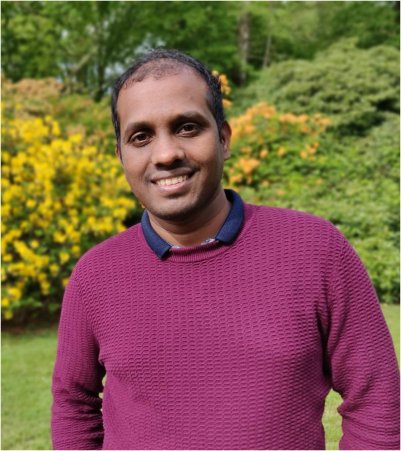Quantifying transcriptional Dynamics by TF-frap
Due to the COVID-19 crisis measures the PhD defence of Kannan Govindaraj will take place (partly) online in the presence of an invited audience.
The PhD defence can be followed by a live stream.
Kannan Govindaraj is a PhD student in the research group Developmental BioEngineering (DBE). His supervisor is prof.dr. H.B.J. Karperien from the Faculty of Science and Technology.
 Transcription factors are DNA binding proteins, upon binding, they can regulate the expression of their target genes. SOX9 and RUNX2 are the master transcription factors of cartilage and bone development, respectively. They play crucial role in the progression of osteoarthritis (OA). Mapping the signaling mechanisms that regulate these transcription factors will help to understand OA pathophysiology at the molecular level. However, studying the activity of transcription factors in live cells at the protein level is a challenging task, due to the lack of suitable methods. Currently, the transcription factor activity is studied indirectly by measuring the expression of their target genes or proteins, by biochemical/molecular biology methods, which are not suitable for live cells. Moreover, these indirect methods yield very poor spatiotemporal resolution of transcription factor activity. Higher spatiotemporal resolution capturing the immediate changes to the activity of transcription factors would help us to understand their secondary interactions with other proteins in response to external stimulation. To bridge the gap, we developed a biophysical method, Transcription Factor – Fluorescence Recovery After Photobleaching (TF-FRAP) and studied the transcriptional dynamics of SOX9 and RUNX2 in human primary chondrocytes (hPCs) and in proliferating and differentiating mesenchymal stem cells (hMSCs).
Transcription factors are DNA binding proteins, upon binding, they can regulate the expression of their target genes. SOX9 and RUNX2 are the master transcription factors of cartilage and bone development, respectively. They play crucial role in the progression of osteoarthritis (OA). Mapping the signaling mechanisms that regulate these transcription factors will help to understand OA pathophysiology at the molecular level. However, studying the activity of transcription factors in live cells at the protein level is a challenging task, due to the lack of suitable methods. Currently, the transcription factor activity is studied indirectly by measuring the expression of their target genes or proteins, by biochemical/molecular biology methods, which are not suitable for live cells. Moreover, these indirect methods yield very poor spatiotemporal resolution of transcription factor activity. Higher spatiotemporal resolution capturing the immediate changes to the activity of transcription factors would help us to understand their secondary interactions with other proteins in response to external stimulation. To bridge the gap, we developed a biophysical method, Transcription Factor – Fluorescence Recovery After Photobleaching (TF-FRAP) and studied the transcriptional dynamics of SOX9 and RUNX2 in human primary chondrocytes (hPCs) and in proliferating and differentiating mesenchymal stem cells (hMSCs).
In this thesis, we describe: i) the method of TF-FRAP, from experimental pre-conditions to detailed protocol and data analysis; ii) the changes in the TF-FRAP rates can be the direct readout of SOX9 transcriptional activity, and we cross-verified TF-FRAP readings by quantifying SOX9 target gene expression by qPCR and chromatin immunoprecipitation (ChIP); iii) the changes to SOX9 dynamics in healthy, preserved and OA hPCs as measured by TF-FRAP and mapped a few external factors that regulate SOX9 activity in hPCs, iv) the changes to SOX9 and RUNX2 dynamics at the subpopulation level in proliferating and multi-lineage differentiating hMSCs, to understand chondrocyte development and hypertrophy.
In addition to quantifying transcriptional dynamics, this thesis presents several novel applications of TF-FRAP, including predicting the differentiation potential of a donor towards a particular lineage, defining the number of subpopulations in a heterogenic population of cells, relationship between spatial arrangement of transcription factors and their dynamics.





